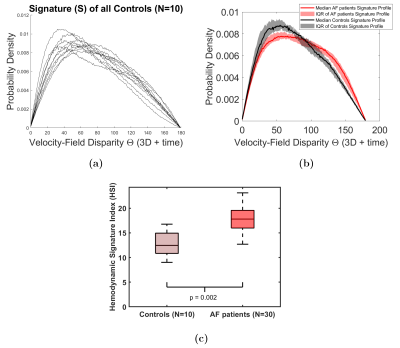Thara Nallamothu1,2, Amanda L. DiCarlo1, Daniel C. Lee3, Daniel Kim1, Rishi Arora3, Michael Markl1,2, Phillip Greenland4, Rod Passman3, and Mohammed S.M. Elbaz1
1Radiology, Northwestern University, Chicago, IL, United States, 2Biomedical Engineering, Northwestern University, Chicago, IL, United States, 3Medicine (Cardiology), Northwestern University, Chicago, IL, United States, 4Preventative Medicine, Northwestern University, Chicago, IL, United States
1Radiology, Northwestern University, Chicago, IL, United States, 2Biomedical Engineering, Northwestern University, Chicago, IL, United States, 3Medicine (Cardiology), Northwestern University, Chicago, IL, United States, 4Preventative Medicine, Northwestern University, Chicago, IL, United States
A
novel reproducible stochastic 4D Flow signature technique is proposed to fully
utilize the time-resolved 3D 3-directional velocity-field information from 4D flow
MRI for quantifying alterations in left atrial flow dynamics in atrial
fibrillation.

Figure 1: Summary
illustration of the steps of the proposed stochastic 4D Flow signature
technique. From left atrial 3D segmentation, the signature is computed from
millions of pairwise 4D flow MRI’s 3D velocity-field vector disparities throughout
the 3D left atrium volume and over the entire systolic time frame. This allows
the signature to comprehensively and quantitatively characterize patient-specific
complex LA flow dynamic alterations, including the interactions between various
changing flow components.

Figure 3: (a) Individual 4D
Flow signature profile of all 10 healthy controls. (b) The median and interquartile range of 4D Flow signatures for
all controls (black, N=10) and all AF patients (red, N=30). (c) Box plot of the derived Hemodynamic
Signature Index (HSI) values for controls and AF patients. P-value represents
the results of the two-way t-test.
